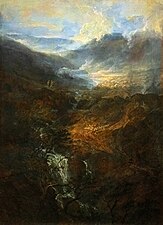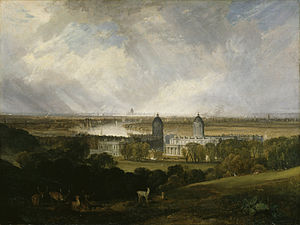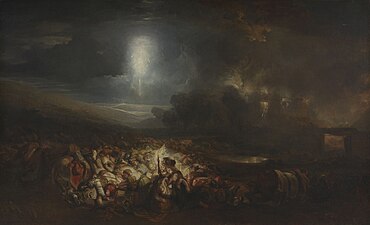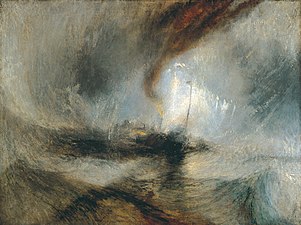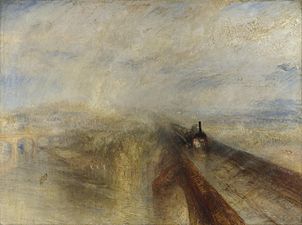J. M. W. Turner
J. M. W. Turner RA | |
|---|---|
 Self-Portrait, oil on canvas, c. 1799 | |
| Born | Joseph Mallord William Turner 23 April 1775 London, England |
| Died | 19 December 1851 (aged 76) Chelsea, London, England |
| Resting place | St Paul's Cathedral |
| Education | Royal Academy of Arts |
| Known for | Paintings |
| Notable work | |
| Movement | Romanticism |
| Signature | |
 | |
Joseph Mallord William Turner RA (23 April 1775 – 19 December 1851), known in his time as William Turner,[a] was an English Romantic painter, printmaker and watercolourist. He is known for his expressive colouring, imaginative landscapes and turbulent, often violent marine paintings. He left behind more than 550 oil paintings, 2,000 watercolours, and 30,000 works on paper.[1] He was championed by the leading English art critic John Ruskin from 1840, and is today regarded as having elevated landscape painting to an eminence rivalling history painting.[2]
Turner was born in Maiden Lane, Covent Garden, London, to a modest lower-middle-class family and retained his lower class accent, while assiduously avoiding the trappings of success and fame. A child prodigy, Turner studied at the Royal Academy of Arts from 1789, enrolling when he was 14, and exhibited his first work there at 15. During this period, he also served as an architectural draftsman. He earned a steady income from commissions and sales, which he often only begrudgingly accepted owing to his troubled and contrary nature. He opened his own gallery in 1804 and became professor of perspective at the academy in 1807, where he lectured until 1828. He travelled around Europe from 1802, typically returning with voluminous sketchbooks.
Intensely private, eccentric, and reclusive, Turner was a controversial figure throughout his career. He did not marry, but fathered two daughters, Evelina (1801–1874) and Georgiana (1811–1843), by the widow Sarah Danby. He became more pessimistic and morose as he got older, especially after the death of his father in 1829; when his outlook deteriorated, his gallery fell into disrepair and neglect, and his art intensified. In 1841, Turner rowed a boat into the
Biography
Childhood
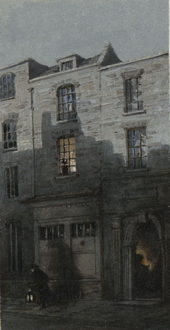
Turner's father William Turner (1745–1829) moved to London around 1770 from South Molton, Devon.[5]
Joseph Mallord William Turner was born on 23 April 1775 and baptised on 14 May.[b] He was born in Maiden Lane, Covent Garden, in London, England.[6] His father was a barber and wig maker.[8] His mother, Mary Marshall, came from a family of butchers.[9] A younger sister, Mary Ann, was born in September 1778 but died in August 1783.[10]
Turner's mother showed signs of mental disturbance from 1785 and was admitted to
Around 1786, Turner was sent to
Many early sketches by Turner were architectural studies or exercises in
Career


Turner entered the
As an academy probationer, Turner was taught drawing from plaster casts of antique sculptures. From July 1790 to October 1793, his name appears in the registry of the academy over a hundred times.
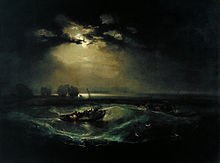
In 1796, Turner exhibited

Turner travelled widely in Europe, starting with France and Switzerland in 1802 and studying in
Turner was a frequent guest of George Wyndham, 3rd Earl of Egremont, at Petworth House in West Sussex, and painted scenes that Egremont funded taken from the grounds of the house and of the Sussex countryside, including a view of the Chichester Canal. Petworth House still displays a number of paintings.
Later life
As Turner grew older, he became more eccentric. He had few close friends except for his father, who lived with him for 30 years and worked as his studio assistant. His father's death in 1829 had a profound effect on him, and thereafter he was subject to bouts of depression. He never married but had a relationship with an older widow, his housekeeper Sarah Danby. He is believed to have been the father of her two daughters Evelina Dupuis and Georgiana Thompson.[26] Evelina married Joseph Dupuis on 31 October 1817. It was recorded that her mother, Sarah Danby, was a witness along with Charles Thompson.[citation needed]

Turner formed a relationship with Sophia Caroline Booth after her second husband died, and from 1846 he lived with her as "Mr Booth" or "Admiral Booth" in her house at 6 Davis's Place (now Cheyne Walk) in Chelsea, until his death in December 1851.[27][28]
Turner was a habitual user of
Turner formed a short but intense friendship with the artist Edward Thomas Daniell. The painter David Roberts wrote of him that, "He adored Turner, when I and others doubted, and taught me to see & to distinguish his beauties over that of others ... the old man really had a fond & personal regard for this young clergyman, which I doubt he ever evinced for the other".[32] Daniell may have supplied Turner with the spiritual comfort he needed after the deaths of his father and friends, and to "ease the fears of a naturally reflective man approaching old age".[32] After Daniell's death in Lycia at the age of 38, he told Roberts he would never form such a friendship again.[33]
Before leaving for the Middle East, Daniell commissioned Turner’s portrait from John Linnell. Turner had previously refused to sit for the artist, and it was difficult to get his agreement to be portrayed. Daniell positioned the two men opposite each other at dinner, so that Linnell could observe his subject carefully and portray his likeness from memory.[33]

Turner died of cholera at the home of Sophia Caroline Booth, in Cheyne Walk in Chelsea, on 19 December 1851.[28] He is buried in St Paul's Cathedral, where he lies near the painter Sir Joshua Reynolds.[5] Apparently his last words were "The Sun (or Son?) is God",[34] though this may be apocryphal.[35]
Turner's friend, the architect Philip Hardwick, the son of his old tutor, was in charge of making the funeral arrangements and wrote to those who knew Turner to tell them at the time of his death that, "I must inform you, we have lost him."[citation needed] Other executors were his cousin and chief mourner at the funeral, Henry Harpur IV (benefactor of Westminster – now Chelsea & Westminster – Hospital), Revd. Henry Scott Trimmer, George Jones RA and Charles Turner ARA.[36]
Art
Style
Turner's talent was recognised early in his life. Financial independence allowed Turner to innovate freely; his mature work is characterised by a chromatic palette and broadly applied atmospheric washes of paint. According to David Piper's The Illustrated History of Art, his later pictures were called "fantastic puzzles". Turner was recognised as an artistic genius; the English art critic John Ruskin described him as the artist who could most "stirringly and truthfully measure the moods of Nature".[37]

Turner's imagination was sparked by shipwrecks, fires (including the burning of Parliament in 1834, an event which Turner witnessed first-hand, and transcribed in a series of watercolour sketches), and natural phenomena such as sunlight, storm, rain, and fog. He was fascinated by the violent power of the sea, as seen at the 1840 Royal Academy of Arts exhibition, where The Slave Ship (1840), and Rockets and Blue Lights (Close at Hand) to Warn Steamboats of Shoal Water (1840) were first shown. A 2003 exhibition at the Clark Art Institute suggested these two paintings were pendants, due in part to their similar content and size.[38]
Turner's work drew criticism from contemporaries. An anonymous review of the 1840 Royal Academy exhibition, later identified as John Eagles, called the displayed paintings “absurd extravagances [that] disgrace the Exhibition”.[39] Sir George Beaumont, a landscape painter and fellow member of the Royal Academy, described his paintings as "blots".[40]
Turner's major venture into printmaking was the Liber Studiorum (Book of Studies), seventy prints that he worked on from 1806 to 1819. The Liber Studiorum was an expression of his intentions for landscape art. The idea was loosely based on Claude Lorrain's Liber Veritatis (Book of Truth), where Claude had recorded his completed paintings; a series of print copies of these drawings, by then at Devonshire House, had been a huge publishing success. Turner's plates were meant to be widely disseminated, and categorised the genre into six types: Marine, Mountainous, Pastoral, Historical, Architectural, and Elevated or Epic Pastoral.[5] His printmaking was a major part of his output, and a museum is devoted to it, the Turner Museum in Sarasota, Florida, founded in 1974 by Douglass Montrose-Graem to house his collection of Turner prints.[41]
His early works, such as
In Turner's later years, he used oils ever more transparently and turned to an evocation of almost pure light by use of shimmering colour. A prime example of his mature style can be seen in Rain, Steam and Speed – The Great Western Railway, where the objects are barely recognisable. The intensity of hue and interest in evanescent light not only placed Turner's work in the vanguard of English painting but exerted an influence on art in France; the Impressionists, particularly Claude Monet, carefully studied his techniques. He is also generally regarded as a precursor of abstract painting.
High levels of volcanic ash (from the eruption of Mount Tambora) in the atmosphere during 1816, the "Year Without a Summer", led to unusually spectacular sunsets during this period, and were an inspiration for some of Turner's work.
John Ruskin said that an early patron, Thomas Monro, Principal Physician of Bedlam, and a collector and amateur artist, was a significant influence on Turner's style:
His true master was Dr Monro; to the practical teaching of that first patron and the wise simplicity of method of watercolour study, in which he was disciplined by him and companioned by his friend Girtin, the healthy and constant development of the greater power is primarily to be attributed; the greatness of the power itself, it is impossible to over-estimate.
Together with a number of young artists, Turner was able, in Monro's London house, to copy works of the major topographical draughtsmen of his time and perfect his skills in drawing. But the curious atmospherical effects and illusions of John Robert Cozens's watercolours, some of which were present in Monro's house, went far further than the neat renderings of topography. The solemn grandeur of his Alpine views were an early revelation to the young Turner and showed him the true potential of the watercolour medium, conveying mood instead of information.
Materials
Turner experimented with a wide variety of pigments.[42] He used formulations like carmine, despite knowing that they were not long-lasting, and against the advice of contemporary experts to use more durable pigments. As a result, many of his colours have now faded. Ruskin complained at how quickly his work decayed; Turner was indifferent to posterity and chose materials that looked good when freshly applied.[43] By 1930, there was concern that both his oils and his watercolours were fading.[44]
Gallery
-
Fisherman's Cottage, Dover, 1790 Yale Center for British Art
-
Clare Hall and King's College Chapel, Cambridge, from the Banks of the River Cam, 1793, watercolour (note that this is the present-day Clare College, formerly named Clare Hall, and not the present-day Clare Hall)
-
The Angler, 1794, Yale Center for British Art
-
Morning amongst the Coniston Fells, 1798, Tate Britain
-
Calais Pier, 1801, oil on canvas, National Gallery, London
-
Dutch Boats in a Gale, 1801, oil on canvas. For his painting Turner drew inspiration from the art of Willem van de Velde the Younger
-
London from Greenwich Park, 1809, oil on canvas, Tate Britain
-
Snow Storm: Hannibal and his Army Crossing the Alps, 1812, oil on canvas, Tate Britain
-
Dort or Dordrecht: The Dort packet-boat from Rotterdam becalmed, 1818, oil on canvas, Yale Center for British Art
-
The Burning of the Houses of Lords and Commons, 16 October 1834, oil on canvas, Cleveland Museum of Art
-
The Burning of the Houses of Lords and Commons, 16th October, 1834, c.1835, oil on canvas, Philadelphia Museum of Art
-
Wreckers Coast of Northumberland, c.1836, oil on canvas, Yale Center for British Art
-
Valley of Aosta: Snowstorm, Avalanche and Thunderstorm, 1836–37, oil on canvas, Art Institute of Chicago
-
The Fighting Temeraire tugged to her last berth to be broken up, 1838, oil on canvas, National Gallery, London
-
Venice – The Dogana and San Giorgio Maggiore, c.1834, National Gallery of Art, Washington D.C.
-
The Slave Ship, 1840, oil on canvas, Museum of Fine Arts, Boston
-
Snow Storm: Steam-Boat off a Harbour's Mouth, c.1842, oil on canvas, Tate Britain
-
The Evening of the Deluge, c.1843, National Gallery of Art, Washington D.C.
-
Rain, Steam and Speed – The Great Western Railway, 1844, oil on canvas, National Gallery, London
-
Norham Castle, Sunrise, c.1845, oil on canvas, Tate Britain
-
The Wreck Buoy, c.1849, Sudley House
-
The Departure of the Fleet, 1850, National Gallery, London
Legacy
Turner left a small fortune, which he hoped would be used to support what he called "decayed artists". He planned an almshouse at Twickenham in west London with a gallery for some of his works. His will was contested and in 1856, after a court battle, his first cousins, including Thomas Price Turner, received part of his fortune.[45] Another portion went to the Royal Academy of Arts, which occasionally awards students the Turner Medal. His finished paintings were bequeathed to the British nation, and he intended that a special gallery would be built to house them. This did not happen because there was disagreement over the final site. Twenty-two years after his death, the British Parliament passed an act allowing his paintings to be lent to museums outside London, and so began the process of scattering the pictures which Turner had wanted to be kept together.
One of the greatest collectors of his work was Henry Vaughan, who when he died in 1899 owned more than one hundred watercolours and drawings by Turner and as many prints. His collection included examples of almost every type of work on paper the artist produced, from early topographical drawings and atmospheric landscape watercolours, to brilliant colour studies, literary vignette illustrations and spectacular exhibition pieces. It included nearly a hundred proofs of Liber Studiorum and twenty-three drawings connected with it. It was an unparalleled collection that comprehensively represented the diversity, imagination and technical inventiveness of Turner's work throughout his sixty-year career. Vaughan bequeathed the most of his Turner collection to British and Irish public galleries and museums, stipulating that the collections of Turner's watercolours should be 'exhibited to the public all at one time, free of charge and only in January', demonstrating an awareness of conservation which was unusual at the time.[46]
In 1910, the main part of the Turner Bequest, which includes unfinished paintings and drawings, was rehoused in the Duveen Turner Wing at the National Gallery of British Art (now
Selby Whittingham founded The Turner Society at London and Manchester in 1975. After the society endorsed the Tate Gallery's Clore Gallery wing (on the lines of the Duveen wing of 1910), as the solution to the controversy of what should be done with the Turner Bequest, Selby Whittingham resigned and founded the Independent Turner Society. The Tate created the prestigious annual Turner Prize art award in 1984, named in Turner's honour, and 20 years later the Royal Institute of Painters in Water Colours founded the Winsor & Newton Turner Watercolour Award. A major exhibition, "Turner's Britain", with material (including The Fighting Temeraire) on loan from around the globe, was held at Birmingham Museum and Art Gallery from 7 November 2003 to 8 February 2004. In 2005, Turner's The Fighting Temeraire was voted Britain's "greatest painting" in a public poll organised by the BBC.[49]
Portrayal
Leo McKern played Turner in The Sun Is God, a 1974 Thames Television production directed by Michael Darlow.[50] The programme aired on 17 December 1974, during the Turner Bicentenary Exhibition in London.[51]
British filmmaker Mike Leigh wrote and directed Mr. Turner, a biopic of Turner's later years, released in 2014. The film stars Timothy Spall as Turner, Dorothy Atkinson, Marion Bailey and Paul Jesson, and premiered in competition for the Palme d'Or at the 2014 Cannes Film Festival, with Spall taking the award for Best Actor.[52][53]
See also
Explanatory notes
- ^ Although Turner was known by his middle name, William, he is now generally referred to by his initials, in order to avoid confusion with the artist William Turner (1789–1862).
- ^ Turner claimed to have been born on 23 April 1775, which is both Saint George's Day and the supposed birthday of William Shakespeare, but this claim has never been verified.[6] The first verifiable date is that Turner was baptised on 14 May, and some authors doubt the 23 April date on the grounds that high infant mortality rates meant that parents usually baptised their children shortly after birth.[7]
- ^ Her illness was possibly due in part to the early death of Turner's younger sister. Hamilton suggests that this "fit of illness" may have been an early sign of her madness.[citation needed]
Citations
- ^ "Turner Society Homepage". Retrieved 27 November 2011.
- ^ Lacayo, Richard (11 October 2007). "The Sunshine Boy". Time. Archived from the original on 12 October 2007.
At the turn of the 18th century, history painting was the highest purpose art could serve, and Turner would attempt those heights all his life. But his real achievement would be to make landscape the equal of history painting.
- ^ "census". BBC. Retrieved 14 February 2020.
- Sinclair, W.p. 468: London; Chapman & Hall, Ltd; 1909.
- ^ ISBN 978-1-84976-386-8. Retrieved 10 March 2016.
- ^ ISBN 978-1-85995-681-6.
- ^ Hamilton 2007, p. 8.
- doi:10.1093/ref:odnb/27854. (Subscription or UK public library membershiprequired.)
- ^ a b Hamilton 2007, Chapter 1.
- ISBN 0-7126-6604-4. (Subscription required.)
- ^ Turner in his Time, Andrew Wilton, H. N. Abrams Books, 1987, p. 45
- ^ "] M W Turner – Connections with Brentford by Carolyn Hammond | Brentford & Chiswick Local History Society".
- ^ ISBN 978-0-500-23830-1.
- ISBN 978-0-500-23830-1.
- ^ Thornbury, George Walter (1862). The life of J.M.W. Turner. p. 8.
- ISBN 0-340-62811-1.
- ^ Thornbury, George Walter (1862). The life of J.M.W. Turner. p. 27.
- Clarendon Press. p. 17.
- ^ a b Hamilton 2007, Chapter 2.
- ISBN 978-0-500-23830-1.
- ISBN 978-0-500-23830-1.
- The Athenaeum. pp. 17–18.
- ISBN 978-0-300-03276-5.
- ISBN 978-0-500-23830-1.
- ISBN 978-0-500-23830-1.
- ISBN 978-1-84976-386-8. Retrieved 14 July 2014.
- ^ "Turner Biography & Chronology – The Turner Society" (PDF). 2 December 2022.
- ^ a b "Settlement and building: Artists and Chelsea Pages 102–106 A History of the County of Middlesex: Volume 12, Chelsea". British History Online. Victoria County History, 2004. Retrieved 21 December 2022.
- ^ "Collection Online: Snuff Box/box". British Museum. Archived from the original on 14 April 2013.
- ^ "Georgian Silver and Agate Pocket Snuff Box Inscribed 'Joseph Mallord William Turner' and the date '1785'". Finch & Co. Archived from the original on 29 September 2015. Retrieved 3 September 2014.
- ^ "Spectacles, glass, snuffbox and cardcase of Turner 1775–1851". Philip Mould & Company. Archived from the original on 4 December 2014. Retrieved 3 September 2014.
- ^ a b Hamilton 2007, pp. 319–320.
- ^ a b Hamilton 2007, p. 356.
- ISBN 978-0-06-097468-8. Retrieved 3 September 2014. (Subscription required.)
- ISBN 978-0-500-23830-1.
- ^ Thornbury, Walter (1862). The Life of J. M. W. Turner, R. A.: Founded on Letters and Papers Furnished by His Friends and Fellow Academicians. Hurst and Blackett. p. 418.
- ^ ISBN 978-0753709696.
- ISBN 978-0-300-09900-3.
- ISBN 978-0-300-09900-3.
- ^ Wilkinson, Gerald (1974). The Sketches of Turner, R.A. London: Barrie & Jenkins.
- ^ "The Turner Museum". The Turner Museum and Thomas Moran Galleries. Archived from the original on 16 February 2010. Retrieved 30 August 2010.
- JSTOR 1506368.
- ISBN 0-8129-7142-6. (Subscription required.)
- The Daily News. 9 January 1930. p. 2. Retrieved 18 May 2014.
- ^ Monkhouse, William Cosmo (1879). The Great Artists: J.M.W. Turner R.A. New York: Scribner and Welford. p. 121. Retrieved 3 September 2014.
- ^ Herrmann, L. (23 September 2004). Vaughan, Henry (1809–1899), art collector. Oxford Dictionary of National Biography.
- ^ "St. Mary's Church Parish website".
St Mary's Modern Stained Glass
- ^ "Joseph Mallord William Turner". City of Westminster. Archived from the original on 3 December 2013. Retrieved 3 September 2014.
- ^ "Turner wins 'great painting' vote". BBC News. 5 September 2005. Retrieved 3 September 2014.
- ^ "The Sun Is God (1974)". British Film Institute. Archived from the original on 21 November 2014. Retrieved 31 March 2015.
- ISBN 978-1-921410-89-5. Retrieved 31 March 2015.
- ^ Child, Ben (23 October 2012). "Timothy Spall to play JMW Turner in Mike Leigh biopic". The Guardian. Retrieved 3 September 2014.
- Film 4. Retrieved 3 September 2014.
- ^ "Polymer £20 note". Bank of England.
- ^ Turner £20 enters circulation
General and cited sources
- ISBN 0-7126-6604-4.
- Finberg, A. J. (1961) [1939]. The Life of J. M. W. Turner, R.A. Oxford: Oxford University Press.
- Hamilton, James (2007). Turner. New York: Random House. ISBN 978-0-8129-6791-3.
- Harrison, Colin (2000). Turner's Oxford. Oxford: Ashmolean Museum.
- Hill, David (2008). Turner and Leeds: Image of Industry. Jeremy Mills Publishing.
- ISBN 978-0-241-96456-9.
- Warburton, Stanley (2008). Discovering Turner's Lakeland. Lytham St Annes: Stanley Warburton.
- Whittingham, Selby (1993–1996). An Historical Account of the Will of J. M. W. Turner, R.A. London: J. M. W. Turner, R.A., Publications.
- Wilton, Andrew (2006). Turner in His Time (revised ed.). London: Thames & Hudson. ISBN 978-0-500-23830-1.
Further reading
- ISBN 0-385-50798-4.
- Barker, Elizabeth E. "Joseph Mallord William Turner (1775–1851)". Heilbrunn Timeline of Art History. The Metropolitan Museum of Art.
- Bockemühl, Michael (2015) [1991]. J. M. W. Turner, 1775–1851: The World of Light and Colour. Köln: Taschen. ISBN 978-3-8228-6325-1.
- Hamilton, James (1998). Turner and the Scientists. London: Tate Publishing. ISBN 978-1-85437-255-0.
- Joll, Evelyn; Butlin, Martin; Herrmann, Luke, eds. (2001). The Oxford Companion to J. M. W. Turner. Oxford: Oxford Univ. Press. ISBN 0-19-860025-9.
- Singh, Iona (2012). "J.M.W. Turner as Producer". Color, Facture, Art & Design. Winchester, UK; Washington, DC: Zero Books. pp. 129–152. ISBN 978-1-78099-629-5.
- Townsend, Joyce (1993). Turner's Painting Techniques. London: Tate Publishing. ISBN 978-1-85437-202-4.
- Venning, Barry (2003). Turner. Berlin: Phaidon Verlag GmbH. ISBN 0-7148-3988-4.
- Wallace, Robert K. (1992). Melville & Turner: Spheres of Love and Fright. The University of Georgia Press. ISBN 0-8203-1366-1. "Wallace explores the stylistic and aesthetic affinities of English landscape painter J. M. W. Turner (1775-1851) and American novelist Herman Melville, establishing Turner as a decisive influence on the creation of Melville's Moby-Dick". (Quotation from dust jacket)
- Williams, Roger (2018). A Year of Turner and the Thames. London: Bristol Book Publishing. ISBN 978-0-9928466-9-5.
External links
- . Encyclopedia Americana. 1920.
- 400 artworks by or after J. M. W. Turner at the Art UK site
- The Turner Society
- Turner & the 1834 Parliament Fire – UK Parliament Living Heritage
- Christie's Videos – Giudecca, La Donna della Salute and San Giorgio Joseph Mallord William Turner, RA Archived 31 May 2013 at the Wayback Machine
- Sotheby's Videos – The Temple of Jupiter Panellenius Joseph Mallord William Turner, RA[permanent dead link]
- Sotheby's Videos – Modern Rome Campo Vaccino and The condition of Modern Rome, Campo Vaccino J. M. W. Turner, RA[permanent dead link]
- J.M.W. Turner exhibition catalogs
- Web site of the Tate Turner Collection, includes the "Turner Bequest" of over 300 Oil paintings and over 30,000 sketches. The catalogue holds records of over 40,000 works by Turner
- Works by J. M. W. Turner at Project Gutenberg
- Works by or about J. M. W. Turner at Internet Archive
- A Brief History of Abstract Art with Turner, Mondrian and More
- "Turner's Whaling Pictures", The Metropolitan Museum of Art Bulletin, v. 73, no. 4 (Spring, 2016)
- Johnson, Ken (3 June 2016). "In Turner Paintings at the Met, the Bloody Business of Whaling". ProQuest 2310050465.
 Rocks at Colgong on the Ganges., engraved by Edward Goodall for Fisher's Drawing Room Scrap Book, 1839, with a poetical illustration by Letitia Elizabeth Landon.
Rocks at Colgong on the Ganges., engraved by Edward Goodall for Fisher's Drawing Room Scrap Book, 1839, with a poetical illustration by Letitia Elizabeth Landon.- "Splendid Lies" review by John Updike of J.M.W. Turner: an exhibition at the National Gallery of Art, Washington, D.C., October 1, 2007 – January 6, 2008; the Dallas Museum of Art, February 10 – May 18, 2008; and the Metropolitan Museum of Art, New York, June 24 – September 21, 2008.
- Turner's poems and other texts (Bibliotheca Augustana)




